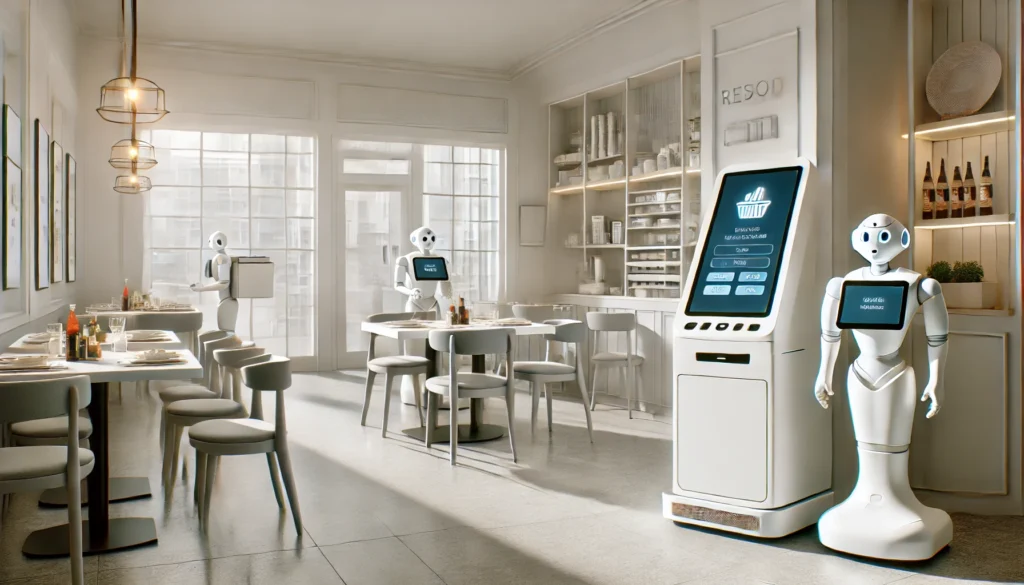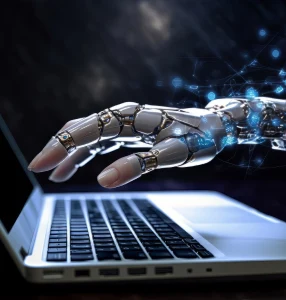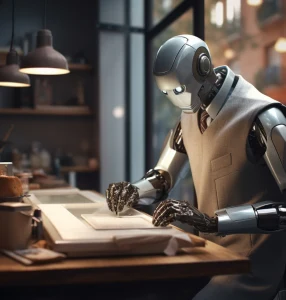Introduction: The Advent of Robotics in the Dining Experience
In an era where technological advancements redefine the boundaries of possibility, the restaurant industry stands on the brink of a revolutionary transformation. This transformation is led by two groundbreaking innovations: robot servers and self-serving kiosks. These technologies are not mere novelties; they represent a significant leap towards operational efficiency, enhanced customer experience, and a reimagined way of dining that marries tradition with futuristic innovation.
The concept of integrating technology into dining experiences is not new. For decades, the restaurant industry has leveraged various technological tools, from online reservation systems to digital menus and payment processes, to streamline operations and cater to the evolving preferences of diners. However, the introduction of robot servers and self-serving kiosks marks a pivotal shift towards a more interactive and autonomous dining environment. These technologies stand at the forefront of the industry’s future, promising to reshape the very essence of dining out.
Robot servers, with their precision and efficiency, challenge the conventional roles within the restaurant service, bringing speed, accuracy, and a touch of futurism to the dining table. On the other hand, self-serving kiosks offer diners unprecedented control over their dining experience, from ordering to payment, fostering a sense of empowerment and personalization. Together, these innovations are not just transforming restaurant operations; they are redefining the expectations of diners and the dynamics of the dining experience itself.
As we delve into the world of robotics in restaurant services, we explore the journey from the initial adoption of these technologies to their current state and the vast potential they hold for the future. This exploration is not just about understanding how robot servers and self-serving kiosks work but also about appreciating the myriad ways they can enhance the dining experience while navigating the challenges they pose. Join us as we embark on this exciting journey, exploring the future of dining where technology and tradition converge to create unforgettable experiences.
The Rise of Robot Servers
In the ever-evolving landscape of the restaurant industry, robot servers have emerged as frontrunners, bringing with them a blend of innovation and controversy. These mechanical waitstaff, powered by sophisticated algorithms and capable of navigating busy dining floors, are transforming the way we think about service in eateries. Here, we delve into the intricacies of robot servers, tracing their origins, evaluating their benefits, and contemplating their challenges.
What Are Robot Servers?
Robot servers are automated robots designed to perform various tasks in restaurants, such as greeting guests, delivering food and drinks from the kitchen to the tables, and even collecting dirty dishes. Equipped with sensors, cameras, and artificial intelligence, these robots navigate through restaurants with surprising agility.
A Look Back at the Origins
The concept of robot servers isn’t entirely new. The first instances of robotic assistance in restaurants date back to the early 2000s, with pioneering establishments in Asia leading the charge. These early versions were more novelty than utility, but they laid the groundwork for the sophisticated models we see today.
Key Benefits of Robot Servers
- Efficiency and Speed: Robot servers operate with precision and can work tirelessly, ensuring that customers receive their orders swiftly and accurately.
- Enhanced Customer Experience: Many diners find interacting with robot servers to be a unique and enjoyable aspect of their dining experience, adding a futuristic touch to their meal.
- Consistency and Reduced Human Error: Robots follow programmed paths and routines, minimizing the chances of errors that can occur with human servers.
Challenges and Limitations
- High Initial Costs: The adoption of robot servers involves significant initial investment in terms of money and time for setup and integration.
- Customer Adaptation: Not all customers are comfortable with the idea of robots serving their meals, preferring human interaction.
- Operational Integration: Meshing robotic servers into the existing workflows of a restaurant can be complex, requiring adjustments to both physical space and human staff roles.
Reflecting on the Robot Revolution
As robot servers glide across dining rooms, they bring with them a host of benefits, from operational efficiency to a sprinkle of novelty. Yet, the transition to robotic service is not without its hurdles, posing financial, technical, and social challenges to restaurant owners and patrons alike. As we continue to explore the role of robotics in restaurant services, the journey of robot servers from gimmicky gadgets to integral parts of the dining experience underscores a broader narrative of innovation, adaptation, and the endless quest for enhancement in the culinary world.
Self-Serving Kiosks: Empowering Customers
Parallel to the robotic revolution transforming restaurant floors are self-serving kiosks, which are redefining the customer experience from the moment they walk in. These interactive terminals allow customers to browse menus, place orders, and make payments without the need for traditional waiter interactions. This section explores the emergence of self-serving kiosks, their advantages, and the challenges they bring to the restaurant industry.
Understanding Self-Serving Kiosks
Self-serving kiosks are digital touchpoints where customers can engage directly with a restaurant’s ordering system. These kiosks are equipped with user-friendly interfaces, offering visual menus that make order customization intuitive and straightforward. From fast-food chains to high-end dining establishments, self-service technology is making its mark, offering a blend of efficiency and personalized service.
Evolution of Self-Service in Dining
The journey of self-serving technology in dining has been marked by significant evolution. Initially popularized by fast-food giants looking to streamline operations and reduce queues, these kiosks have now found their way into various segments of the industry. The technology has advanced from simple order-placement stations to sophisticated systems offering recommendations, loyalty program integration, and even AI-driven personalization.
Advantages of Self-Serving Kiosks
- Enhanced Customer Control and Personalization: Customers enjoy the ability to browse the menu at their own pace, customize their orders to their liking, and even discover new favorites through personalized recommendations.
- Operational Efficiency and Cost Savings: Kiosks reduce the need for staff dedicated to taking orders, allowing restaurants to reallocate human resources to more critical areas like food preparation and customer service.
- Reduced Wait Times and Increased Accuracy: Orders placed via kiosks are directly transmitted to the kitchen, minimizing order errors and speeding up the overall service time.
Facing the Challenges
- Diminishing Human Interaction: One significant drawback is the potential loss of personal interaction that can define the dining experience. This can impact customer satisfaction, especially among those who value traditional service.
- Technical Glitches and Reliance: Like any technology, self-serving kiosks are not immune to technical issues, which can lead to customer frustration and operational delays.
- Privacy and Security Concerns: With customers entering personal information, including payment details, the risk of data breaches and privacy violations is a concern that restaurants must address.
Navigating the Self-Service Landscape
Self-serving kiosks stand at the forefront of technological innovation in the restaurant industry, offering a dual promise of enhanced customer autonomy and operational efficiency. However, as restaurants navigate the integration of these kiosks into their service models, the challenges of maintaining a personal connection and ensuring technological reliability come into sharper focus. The future of self-serving technology in dining is bright, provided these hurdles can be overcome, paving the way for a more interactive, efficient, and personalized dining experience.
Combining Human Touch with Robotic Efficiency
As the restaurant industry embraces the technological marvels of robot servers and self-serving kiosks, a pivotal question emerges: How can establishments balance the efficiency of robotics with the irreplaceable value of human interaction? This section delves into the strategies restaurants are adopting to harmonize technology with the traditional dining experience, ensuring that the essence of hospitality remains intact.
The Harmony Between Man and Machine
Incorporating robotic servers and self-service kiosks into the dining experience doesn’t necessitate the elimination of human elements. Instead, many forward-thinking restaurants are finding innovative ways to blend these technologies with human warmth and hospitality, ensuring that diners receive the best of both worlds.
Case Studies: Successful Integration
- Robot-Assisted Dining: Explore the stories of restaurants that have seamlessly integrated robot servers alongside human staff. These establishments use robots for routine tasks like food delivery and dish collection, allowing human staff to focus on customer service, engagement, and nuanced tasks that require a personal touch.
- Kiosks and Human Interaction: Examine how some eateries are positioning self-service kiosks as an option rather than a replacement for human interaction. By doing so, they cater to customers who prefer technology for convenience and those who value traditional service, ensuring a personalized approach to customer service.
Customer Feedback and Acceptance
- Adaptation and Reception: Dive into customer reactions to the blend of human and robotic service. Surveys and feedback highlight a growing acceptance among diners who appreciate the novelty and efficiency of technology while still valuing the human connection.
- The Role of Staff in Technology-Rich Environments: Insights into how restaurant staff perceive their roles evolving in an increasingly automated industry. Training and adaptation are key, as employees shift towards more value-added activities, enhancing the overall dining experience.
Strategies for Balancing Technology with Human Touch
- Training Staff for Enhanced Roles: With routine tasks automated, human staff can be trained for roles that require empathy, critical thinking, and personal engagement—qualities that robots cannot replicate.
- Designing Interactive Dining Experiences: Innovative dining concepts that use technology to create interactive experiences for guests, without overshadowing the importance of human service.
- Personalization and Customer Service: Utilizing technology to gather insights on customer preferences for personalized service, while leveraging human staff to interpret and act on these insights in a manner that feels personal and thoughtful.
The Path Forward: Embracing Technology without Losing Essence
The journey towards integrating robotics and self-service technology in restaurants is not just about adopting new tools; it’s about reimagining the dining experience in a way that enhances efficiency without sacrificing the human connection. By highlighting successful case studies and strategies, this section illustrates that the future of dining lies in the artful integration of technology with the timeless value of human touch. As restaurants navigate this new terrain, the goal remains clear: to create memorable dining experiences that marry the best of both worlds, where technology serves to complement, not replace, the human element that lies at the heart of hospitality.
Conclusion: Navigating the Convergence of Tradition and Technology
The restaurant industry’s foray into robotics and automated services marks a pivotal shift in how we envision the dining experience. As we’ve explored the realms of robot servers, self-serving kiosks, and the delicate balance between technological efficiency and human warmth, it’s evident that these innovations hold the power to transform the industry in profound ways. However, this journey is not just about embracing the new; it’s about redefining our connection with food, service, and each other in the digital age.
The potential of robot servers and self-serving kiosks to revolutionize restaurant operations is immense, offering unparalleled efficiency, personalization, and insights into consumer behavior. Yet, as we chart this course towards a more automated future, the challenge lies in ensuring that technology enhances rather than detracts from the human elements that lie at the core of the dining experience. The future of dining, therefore, is not a choice between human or machine but a synergy of both, where technology serves to amplify the joy of dining out.
Join the Conversation on the Future of Dining
Have you dined at a restaurant that uses robot servers or self-serving kiosks? What was your impression? Did the technology enhance your dining experience, or did you find yourself missing the human touch? Share your stories and thoughts with us. The landscape of restaurant technology is evolving rapidly.
To stay up to date on the latest trends, innovations, and discussions around robotics in dining, follow our blog and join our community of food enthusiasts, tech aficionados, and industry professionals. As we stand at the crossroads of tradition and technology, your insights and experiences are invaluable in shaping the future of dining. Together, let’s explore the possibilities that lie ahead, ensuring that as the restaurant industry evolves, it does so in a way that enriches our collective dining experiences. Join the conversation, and let’s reimagine the future of dining together.
Read this article about 7 Innovations and Technologies of Revel Systems.






